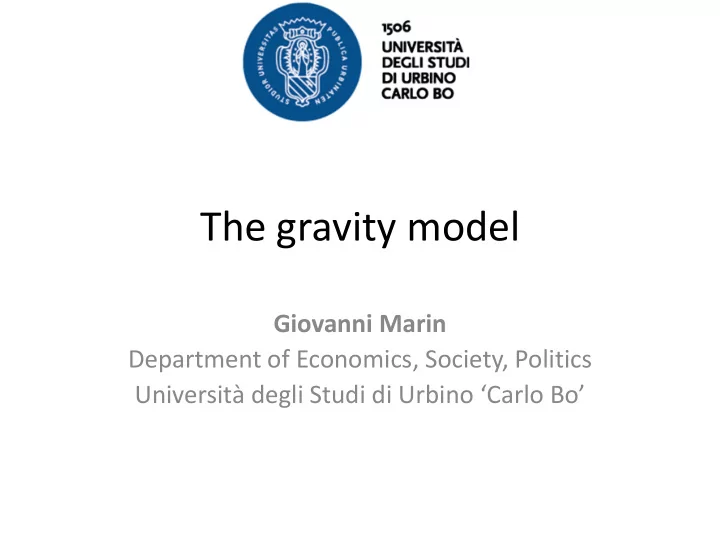

The gravity model Giovanni Marin Department of Economics, Society, Politics Università degli Studi di Urbino ‘Carlo Bo’
References for this lecture • BBVG – Chapter 6, paragraph 6.4 Spring 2017 Global Political Economy 2
Law of gravity in physics • Newton’s law of universal gravitation • The force of attraction between two particles is directly proportional to their masses and inversely proportional to the (square of) their distance m m 1 2 F G 2 r log( ) log( ) log( ) log( ) 2 log( ) F G m m r 1 1 Spring 2017 Global Political Economy 3
From physics to economics (trade) • Jan Tinbergen proposed to adapt the Law of gravity to the issue of international trade • Size of ‘ particles ’ ( countries) – Economic size – Indicator total GDP (or, alternatively, total populatioN) • Distance geographical distance • Force bilateral export from country i to country j log( ) log( ) log( ) log( ) ' Exp GDP GDP Dist X ij i j ij ij ij Spring 2017 Global Political Economy 4
Size in the gravity model • GDP represents total income that is distributed to residents in a country • This income can be spent in purchasing either domestic or imported goods • The larger total income , the greater the potential demand for import • GDP also represents total production that takes place in a country • The larger total production , the greater the amount of production that can be exported • Role of economies of scale in trade models! Spring 2017 Global Political Economy 5
Distance in the gravity model • Geographical distance is strictly connected to transportation costs • Baseline assumption trade costs are proportional to geographical distance Spring 2017 Global Political Economy 6
Results for the EU (my elaboration, period 2007-2014) Variable Coefficient log(GDP i ) 0.663 log(GDP j ) 0.703 log(distance) -0.846 R squared 73.1 percent (share of explained variance) Spring 2017 Global Political Economy 7
Augmenting the gravity model • Alternatively to GDP , population may be used to account for size • GDP per capita is also likely to influence import and export (and its composition) • The distribution of GDP per capita within country has an influence on the level and composition of trade – People with different levels of income per capita have different propensity to import Spring 2017 Global Political Economy 8
Augmenting the gravity model • Geographical distance is a rather crude proxy of transportation costs – Modes of transport – Environmental barriers (mountains, sea, etc) – Infrastructure • Other trade costs need to be taken into account – Tariff and non-tariff barriers – Presence (or absence) of trade agreements Spring 2017 Global Political Economy 9
Augmenting the gravity model • Other distances matter – Cultural distance – Institutional distance – Economic distance • Proxy variables used in gravity models to account for these distances – Former colonial relationship – Contiguity – Military conflicts – Common language – Common law vs civil law – … Spring 2017 Global Political Economy 10
Augmenting the gravity model • Trade and FDI are substitute strategies for firms that want to serve foreign markets or take advantage ofspecific conditions in foreign countries • Distance and size matter both for trade and FDI • The gravity model has also been extended to evaluate the drivers of FDI Spring 2017 Global Political Economy 11
Recommend
More recommend